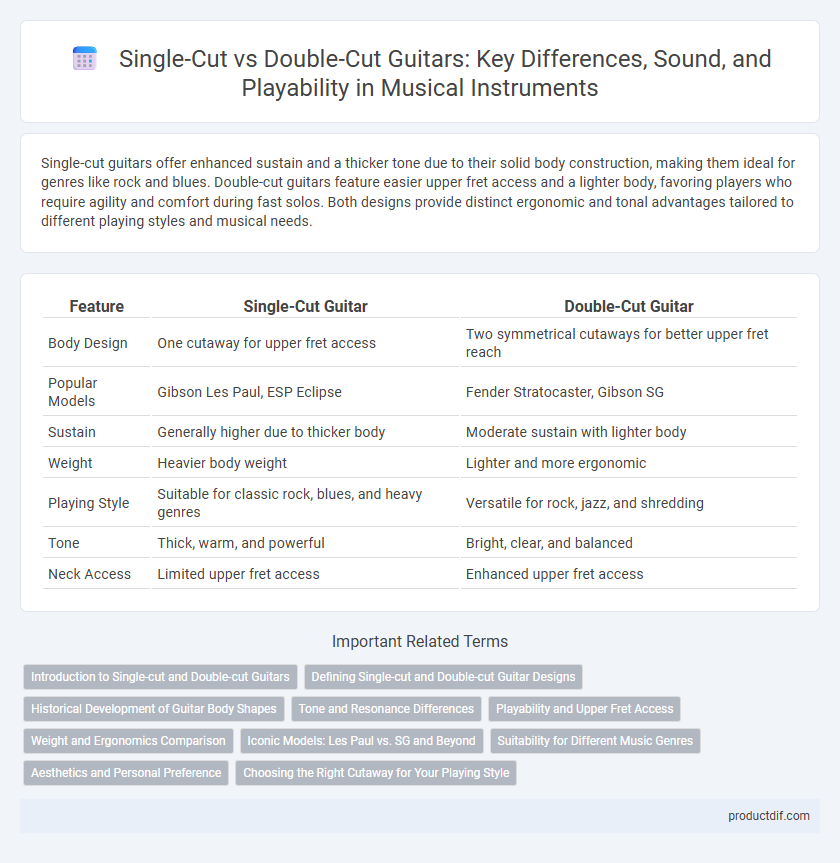Single-cut guitars offer enhanced sustain and a thicker tone due to their solid body construction, making them ideal for genres like rock and blues. Double-cut guitars feature easier upper fret access and a lighter body, favoring players who require agility and comfort during fast solos. Both designs provide distinct ergonomic and tonal advantages tailored to different playing styles and musical needs.
Table of Comparison
| Feature | Single-Cut Guitar | Double-Cut Guitar |
|---|---|---|
| Body Design | One cutaway for upper fret access | Two symmetrical cutaways for better upper fret reach |
| Popular Models | Gibson Les Paul, ESP Eclipse | Fender Stratocaster, Gibson SG |
| Sustain | Generally higher due to thicker body | Moderate sustain with lighter body |
| Weight | Heavier body weight | Lighter and more ergonomic |
| Playing Style | Suitable for classic rock, blues, and heavy genres | Versatile for rock, jazz, and shredding |
| Tone | Thick, warm, and powerful | Bright, clear, and balanced |
| Neck Access | Limited upper fret access | Enhanced upper fret access |
Introduction to Single-cut and Double-cut Guitars
Single-cut guitars feature a single rounded cutaway that allows easier access to higher frets, commonly associated with models like the Gibson Les Paul. Double-cut guitars have symmetrical cutaways on both sides of the neck, providing enhanced upper-fret accessibility and balanced weight distribution, exemplified by the Fender Stratocaster. These design differences influence playability, comfort, and aesthetic appeal, catering to varying styles and preferences among guitarists.
Defining Single-cut and Double-cut Guitar Designs
Single-cut guitars feature a single cutaway on the guitar body, allowing easier access to higher frets primarily on the lower horn, which enhances playability for lead guitarists. Double-cut guitars have symmetrical cutaways on both sides of the neck, improving balance and providing unrestricted access to upper frets on both edges of the fretboard. These design distinctions influence the guitar's ergonomics, tonal characteristics, and aesthetic appeal, impacting player preference and style.
Historical Development of Guitar Body Shapes
The historical development of guitar body shapes reveals that single-cut guitars, characterized by a single cutaway for easier access to upper frets, emerged prominently in the 1950s with models like the Gibson Les Paul. Double-cut guitars, featuring symmetrical double cutaways, gained popularity earlier with designs such as the Gibson SG in the early 1960s, offering enhanced playability and balance. These evolving body shapes reflect the guitar's functional adaptation and aesthetic trends driven by changing musical styles and player preferences.
Tone and Resonance Differences
Single-cut guitars typically offer a warmer, more focused tone with enhanced sustain due to their solid body and limited upper bout cutaways, which contributes to greater resonance and sustain. Double-cut guitars provide a brighter, more balanced sound with increased upper fret access, promoting enhanced playability and tonal clarity through their thinner body contours. The construction and body shape of each guitar directly influence vibration transfer and resonance, affecting the overall tonal character and dynamic response.
Playability and Upper Fret Access
Single-cut guitars typically feature a thicker body and a less contoured neck joint, which can limit upper fret access and reduce playability for complex solos. Double-cut guitars offer enhanced upper fret access due to their symmetrical body design and deeper cutaways, allowing guitarists to reach higher notes with greater ease and comfort. This ergonomic advantage makes double-cut designs especially popular among lead guitarists seeking fluid playability across the entire fretboard.
Weight and Ergonomics Comparison
Single-cut guitars typically weigh more due to their larger body mass, which can impact overall playing comfort during extended sessions. Double-cut guitars offer better ergonomics with easier access to higher frets and a balanced feel, reducing strain on the player's shoulder and wrist. Weight distribution in double-cut designs enhances maneuverability, making them preferable for dynamic stage performances.
Iconic Models: Les Paul vs. SG and Beyond
The single-cut Les Paul and double-cut SG guitars each offer distinct tonal characteristics and playability, with the Les Paul known for its solid, sustain-rich sound and the SG favored for its lighter weight and sharper attack. Iconic Les Paul models often feature a thicker mahogany body with a maple top, while SG guitars utilize a thinner, double-cutaway design for easier upper fret access. Beyond these classics, manufacturers continue to innovate with hybrid models that blend the ergonomic advantages of double-cut designs with the powerful resonance typical of single-cut guitars.
Suitability for Different Music Genres
Single-cut guitars, often favored in blues and rock genres, provide a thicker, warmer tone suited for powerful riffs and sustained solos. Double-cut guitars excel in genres like jazz and metal due to their ergonomic design, allowing easier access to higher frets and a brighter, more versatile sound. Musicians seeking aggressive, fast-paced playing styles often choose double-cut models for their playability and tonal clarity.
Aesthetics and Personal Preference
Single-cut guitars feature a symmetrical body with one cutaway, offering a classic, vintage aesthetic favored by blues and rock players; double-cut guitars have two cutaways, providing a modern, balanced look preferred for ease of upper-fret access. The choice between these styles often hinges on personal preference related to visual appeal and playing comfort rather than tonal differences. Musicians prioritizing vintage charm typically select single-cut models, while those valuing ergonomic design lean toward double-cut designs.
Choosing the Right Cutaway for Your Playing Style
Single-cut guitars offer increased sustain and a solid body structure preferred by blues and rock players who favor heavier tones and strong midrange presence. Double-cut guitars provide easier upper-fret access and lighter body weight, making them ideal for shredders and jazz musicians who require agile finger movement and dynamic playability. Selecting between single-cut and double-cut designs depends on prioritizing tonal depth versus ergonomic reach based on your specific musical genre and technique demands.
Single-cut guitar vs Double-cut guitar Infographic

 productdif.com
productdif.com